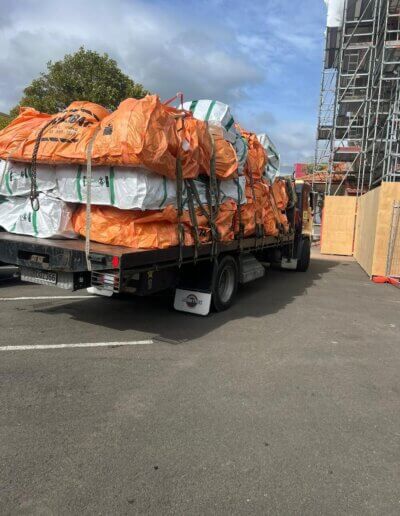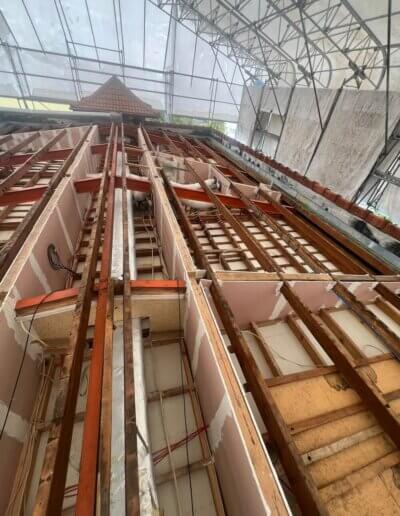CASE STUDY
Asbestos removal and environmental decontamination of roofing
Project:
For this project, the Environmental Services team removed and disposed of 340m2 of asbestos containing materials, including roof sheets, roofing paper, chicken mesh, and insulation in the roof void. We then also decontaminated the void space under the roof.
Location
Knights Road, Lower Hutt
Asbestos removal from roofing
For this project, the Environmental Services team removed and disposed of 340m2 of asbestos containing materials, including roof sheets, roofing paper, chicken mesh, and insulation in the roof void. We then also decontaminated the void space under the roof.
The team managed to produce ten 3m3 hazmat bags filled with asbestos waste, which we moved into local landfill safely for correct disposal of hazardous waste.
One of the challenging parts of this project was the fact that the roof – and therefore all the asbestos containing materials – were multiple stories up from the ground floor in a large hotel. Therefore, moving the waste products out safely wasn’t as straightforward as usual. Our team overcame this challenge by using a large mobile elevated workloadP to load waste down to the ground safely.
Overall, the job went smoothly as planned and was completed in just 5 days. As always, the assessor was extremely satisfied with our skilled team’s standard on environmental decontamination of the roof void.
The History of Super Six Roofs
Corrugated asbestos cement sheet, also known as ‘super six’ roofing, is a common sight throughout New Zealand, particularly in industrial and commercial areas. It was also used on houses and sometimes used as boundary fencing. Of all the non-friable asbestos containing materials used in construction , super six roofing presents one of the highest health risks due to its exposure to the elements. A large quantity of super six roofs are unsealed, meaning that they are more susceptible to weathering.

What is super six roofing made of?
Super six roofing material is made primarily of concrete and asbestos, and can contain all three types of asbestos. As concrete is an alkaline (basic) material, it is susceptible to materials which are acidic in nature including rainwater. The slightly acidic rainwater reacts with the concrete, breaking it down slowly over time resulting in asbestos fibre release. These fibres then wash into gutters, rainwater tanks and on to the surrounding soil if the gutters are blocked or leaking. The debris in your gutters may contain asbestos fibres and these fibres can easily become airborne when you clean the gutters, particularly if it is dry.
Rainwater running off the roof and into the soil can result in the soil surrounding your house being contaminated with asbestos fibres. This is sometimes referred to as a ‘halo’ around a house. When the super six roof deteriorates, it can also start to crack, which leaves openings for contaminated rainwater to leak into your ceiling space or the area below the roof.
The risk of exposure to the elements
Wind can also cause the overlapping super six sheets to rub together, which releases asbestos fibres below the roof sheets. If there is a lining below the roof sheets, it can catch and contain the fibres if it is in good condition. If there is no lining or if it is damaged or torn, asbestos fibres can sift down into the ceiling cavity below. If there is no ceiling cavity, which is the case for commercial or industrial buildings, asbestos fibres can settle on flat surfaces such as floors, ledges and false ceilings. For those buildings with ceiling insulation, it is highly likely that this would be contaminated with asbestos fibres.
The risks of poor asbestos removal
One last potential source of contamination in a building is from improper removal of a super six roof. PRO Environmental Services have conducted numerous projects on buildings where fibre cement debris and fixings have been found in ceiling cavities. Surface sampling has also confirmed the presence of asbestos fibres, indicating that the area was not vacuumed correctly if at all.
If you have a super six roof or you think your building may have had one in the past, it is recommended that you do not enter the ceiling space until you have had it assessed by an asbestos surveyor.
Asbestos removal services in Wellington, Kapiti and Wairarapa
Our Asbestos Removal local experts proudly serve in Wellington, Kapiti and the Wairarapa area. That includes all small towns and suburbs such as Lower Hutt, Upper Hutt, Wellington Central, Karori, Hataitai, Southgate, Raumati, Waikanae, Levin, and more. For projects outside these areas, feel free to get in touch, as we are happy to go further and help you with your asbestos removal needs at your location.
Contact us today for a free asbestos quote.







